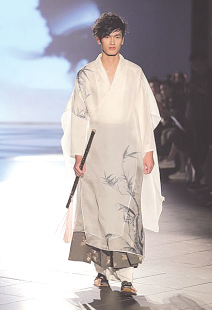
A fashion show held in Suzhou Museum displays the museum collaboration with chic brands on e-commerce platform . Calligraphy and landscape paintings were designed into modern chic. (Photo provided to China Daily)
Promoting love for culture
For Su Yi, deputy director of the information department of the museum, its efforts to promote the design of games and emoji transcend financial considerations; the museum is keen to promote a love of traditional culture among the young, she says.
The museum developed more than 8,000 products involving clothes, bags, porcelain, paintings, accessories and jewelry. Revenue from its products sold online and in stores exceeded 1 billion yuan ($150 million) last year.
The museum put a mobile phone holder on sale last year, and within an hour of it going on the market about 1,500 had been sold. Apart from merchandise, the museum is also becoming involved in producing films, animations and literature.
Ye Chen, 28, who works for a bank in Shanghai, and who is a self-avowed aficionado of cultural merchandise, says that anything she has bought from the Palace Museum's online shop is creative and attractive. Many of her friends and colleagues follow her to buy them after seeing her purchases.
"I don't like tourist products that simply have a picture from a museum's collection on them or that are poorly done reproductions. I want something that doesn't just appeal to the eye but is useful, too."
What she has bought from national-level museums has been reasonably priced, but the merchandise many other museums sell is overpriced, she says.
Yu Renguo, founder of Dream Castle Culture Company of Beijing, which designed the red fox Ali for Prince Kung's Palace Museum, says: "China is becoming a lucrative market for cultural and creative products. Many foreign companies are also interested in it."
This year he was invited to give a speech on the subject in Las Vegas and Seou, he says.
When he set up his company seven years ago it was difficult to sell cultural and creative products, but with the growing middle class and the young generation, the demand for high-quality museum products has soared, he says.
His collaboration with Prince Kung's Palace Museum in creating Ali was a first for his company, he says, and he is confident work with other museums is in the pipeline.
"Yes, people are excited about the industry, but we still need to make a greater effort in developing products, ones that cover a wide range of areas and that are truly unique. We should not limit ourselves to fridge magnets, scarves, bookmarks and cups."


















































